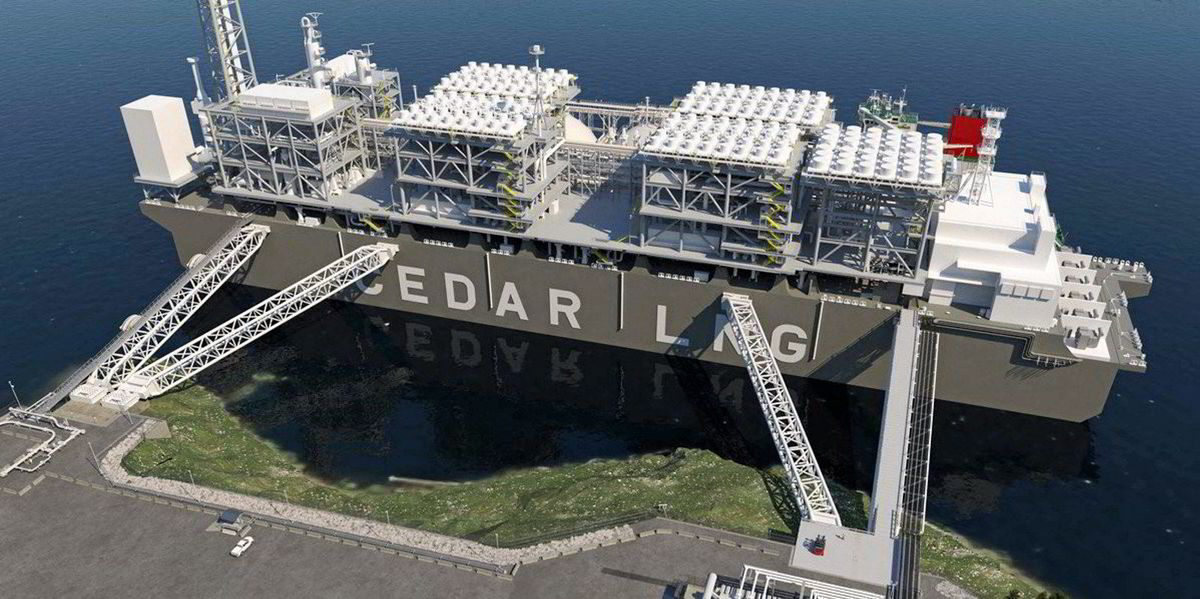[ad_1]
Cedar LNG, a partnership of the Haisla Nation and Pembina Pipeline Corporation, is on track to make a Final Investment Decision (FID) by the end of June.
If the $4.6-billion project in B.C. gets the financial green light, it will aim for arrival of its floating LNG production plant in 2028, along with a connection to the Coastal GasLink (CGL) pipeline for the natural gas to feed the plant.
Operations would begin in late 2028, and after that the first shipment of LNG could be sent off to Asia.
It will be the first majority Indigenous-owned LNG facility in Canada — and in the world. The project is farther down the road toward an FID than is Ksi Lisims LNG, a project of the Nisga’a Nation in partnership with Rockies LNG and Western LNG. That is in early stages of government approvals.
Highlights of the Cedar LNG project:
- The operation will produce some three million tonnes of liquefied natural gas per year. (That compares with 14 million tonnes by LNG Canada,12 million by Ksi Lisims, and 2.1 million by Woodfibre LNG.)
- Powered by clean energy from B.C. Hydro, Cedar LNG says it will be one of the lowest carbon-intensity LNG facilities in the world.
- It will initially produce less than one-third of the global industry average for emissions from an LNG plant, and plans to achieve net-zero emissions by 2030.
- “It will contribute to the displacement of coal as an energy source in Asia, achieving higher prices for Canadian producers, contributing to lower overall global emissions, and enhancing global energy security.”
- Cedar has all the required regulatory approvals from government authorities, including an environmental assessment certificate from the B.C. government, a positive decision statement from the federal minister of environment and climate change, a pipeline permit for the connection to CGL, and an LNG facility permit from the BC Energy Regulator.
- Cedar notes “strong support of neighbouring Indigenous Nations and communities” and sees neighbouring First Nations benefitting as well as the host Haisla Nation. Cedar’s Community Investment Program also aims to benefit First Nations and other communities in the region.
- In the regulatory processes, government officials consulted the Gitga’at First Nation, Gitxaała Nation, Haida Nation, Kitselas First Nation, Kitsumkalum First Nation, Lax Kw’alaams Band, Metlakatla First Nation and Métis Nation British Columbia.
- The Cedar LNG project has agreements with major engineering, procurement, and construction contractors.
- Pre-construction work is already under way, including tree clearing and rough grading activities at Cedar LNG’s planned marine terminal. The floating plant will be moored to Haisla territory, 8.5 km southwest of Kitimat and across Douglas Channel from the nation’s Kitamaat Village.
- Up to 500 people will be working at Cedar LNG during the peak period of construction. Approximately 100 people will be working at the facility full-time during its operation.
- Cedar LNG expects to send off a loaded LNG carrier once every seven to 10 days or up to 50 times a year.
- To reach the open ocean, each LNG carrier will travel through Douglas Channel to Hecate Straight, using the existing deep-water shipping lane and accompanied by green tugs (powered by electricity or LNG) from HaiSea Marine, a partnership of the Haisla and Seaspan.
- When it comes to shipping LNG, the terminal will be about half the distance to Asian markets compared to terminals on the U.S. Gulf Coast. That means lower shipping costs — and less emissions from the vessels.
Crystal Smith, elected chief councillor of the Haisla Nation (and chair of the First Nations LNG Alliance): “The Cedar LNG project will be the largest First Nation-owned infrastructure project in Canada, creating jobs, contracting and other economic opportunities for the Haisla Nation, the community of Kitimat, neighbouring Indigenous nations, and the local region.
“Cedar LNG represents long-term growth for our region in a way that protects our land and environment, and. . . with innovative technology and reduced environmental footprint.”
The Haisla will own 50.1% of the project.
As a result of the LNG Canada project, the Haisla have already been able to build a new apartment complex and a new health centre, and have invested $5 million in a new language and culture centre to help preserve the Haisla language. Now the nation looks toward game-changing benefits from the Cedar LNG venture.
Nearly 93% of Haisla members who participated in a recent ratification vote supported plans by the elected band council to borrow money for the project.
“Participating in developing these resources provides independence,” says Smith. “It’s the only solution for my nation and other Indigenous communities.”
Scott Burrows, Pembina’s president and CEO: “We are on track to deliver an Indigenous majority owned, best-in-class LNG facility – one that will benefit the Haisla Nation, Pembina and its customers, the region, and all of Canada, while meaningfully contributing to the transition to a lower-carbon economy.”
Karen Ogen, CEO of the First Nations LNG Alliance, on LNG development: “It’ll help boost our Canadian economy, it’ll help B.C.’s economy, and most specifically it will help the Indigenous people and our economy.”
And she adds: “Canadian LNG is a direct route to jobs and benefits for Indigenous and non-Indigenous people alike. . . . Canadian LNG is Indigenous LNG, and that is good for the world and good for all of us here.”

[ad_2]
Source link
